PAGE 65 – September 2007
H O T I D E A S F O R S M A L L R A I L R O A D S
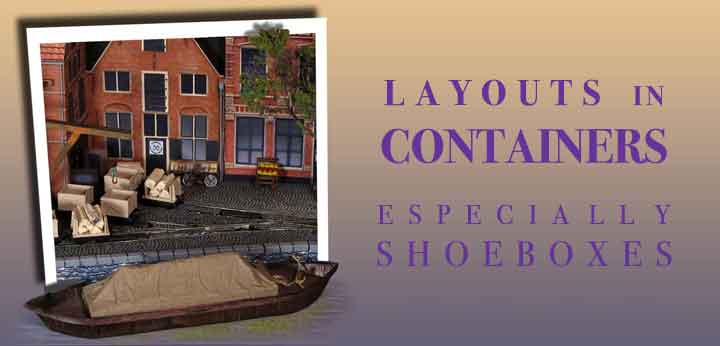
OOB Photo by John Hubbard. See story below.
There’s a fascination among model rails for building layouts in various containers,
ranging from old TV sets to washtubs and even discarded microwave ovens!
And of course, in shoeboxes — a venue that was first developed in these
pages and that has spread to become virtually a worldwide enthusiasm.
Here’s our annual roundup of layouts built in imaginative containers,
including an update on the latest, greatest shoebox constructions.
INTRODUCING THE GRANDEST CONTAINER YET…
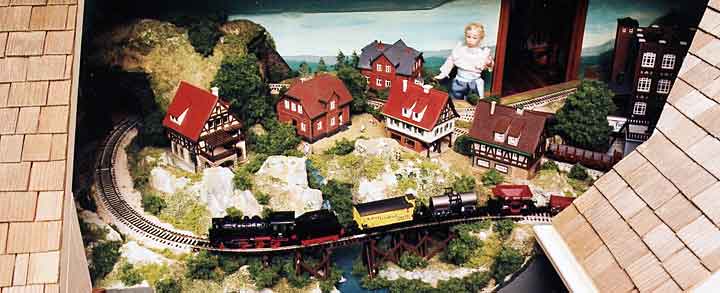
Filling the attic of a marvelous Queen Anne Victorian 1:12 dollhouse is this Z-scale model railway. It represents a large-scale Gauge 3 layout, very popular in the Edwardian era (early 20th Century) for filling rooms in the houses of the well-to-do. Both the dollhouse and the Z-scale railway were designed and built by Fred Stephenson, from Overland Park, Kansas, USA.
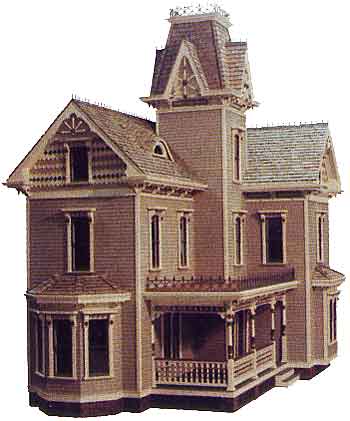
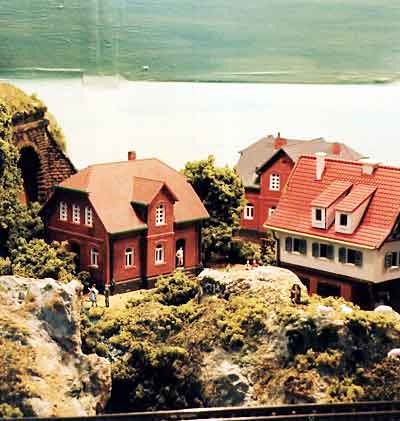
A professional architect, Fred constructed the dollhouse (above left) virtually board by board using plenty of authentic period gingerbread (scratchbuilt in 1:12 scale). The buildings in the model railroad (above right) are also scaled down from real period structures, including a Victorian-era brick factory.
As seen below, the layout was built in sections in order to fit it into the space beneath the roof beams, at the head of the attic stairs. Dollhouse Miniatures magazine called the finished house “Fred’s masterpiece.” These are the first published photos of this little operating railway that Fred tucked into the upper story of his grandest of layout containers.
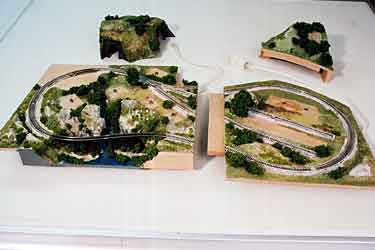
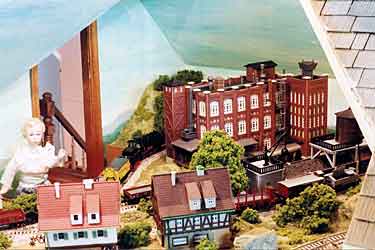
FROM THE SUBLIME TO THE … ABSURD!
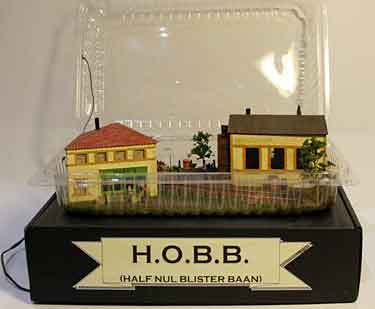
When a Dutch model railroad forum, inspired by this website, inaugurated an annual contest for very small layouts, Albert Winkel decided to have a go. He built H.0.B.B. (Half Nul Blister Baan) in a cake blister package from the grocery store! As you might expect, the name translates to H0 Blister Railway.
The layout measures about 15x27cm (6×10½in), and the black box underneath with controls and electrics measures 20x30cm (8x12in). There’s just room for a single locomotive, which switches from track to track using the sector plate behind the shop. The loco and the buildings were scratchbuilt out of card to 1:87 scale.
Albert lives in Ter Apel, Netherlands. He won the contest and took home a cash prize of 250 euros!
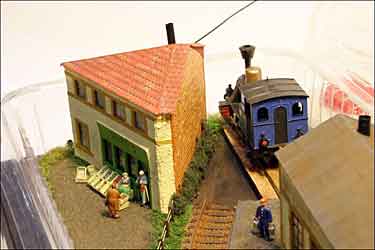
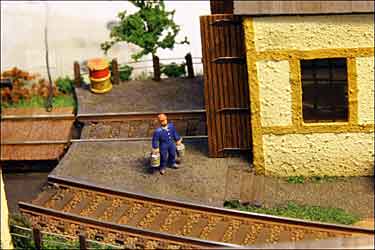
AND SPEAKING OF THINGS FOUND IN THE KITCHEN…
Coincidentally, the second annual winner of the Dutch small-layout contest described above was young Kevin Boogaard, who built an N-scale layout in a 15in computer monitor (described in Scrapbook #56a). Kevin, with assistance from his father, Martin, has completed another display in a container … this time in a microwave oven. This N-scale diorama includes a working turntable and scenery lights, and the microwave’s buttons and displays still work! If you “cook” your train in the oven, the turntable rotates in a circle.
For more information, see their website.
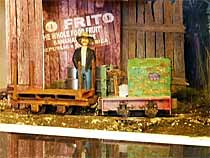
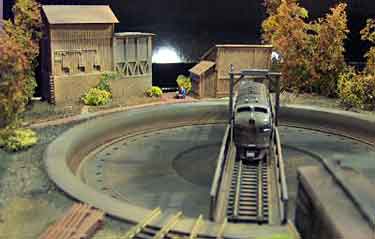
THE CLASSIC WINE BOX — A CLASSY RECEPTACLE
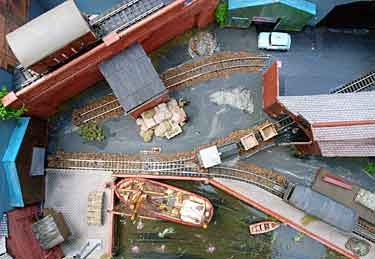
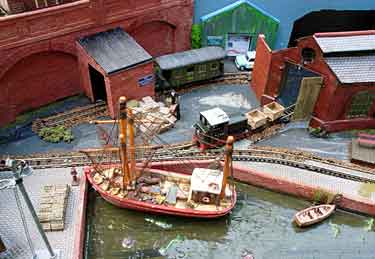
David Mitchell, who lives in Reading, England, built a OO9 (HOn30) waterfront layout in a 12-bottle wooden wine box. Kydmour Quay is a self-confessed “clone” of Carl’s Imports (but a mirror image), measuring 20x13in (51x33cm). The focal fishing boat, reports David, is “an ornament bought from a seaside gift shop for just £3 ($6)!”
WHAT’S BLACK AND WHITE AND OPERATES?
Why, a monochrome layout powered by puppet strings, of course! Bob Hughes, from Sandbach, Cheshire England, has built an ingenious small layout in a cardboard fruit box, then added an unusual twist. He built it in black and white, rather than full color!
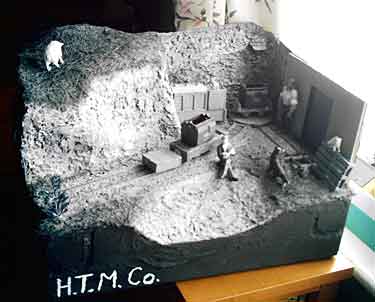
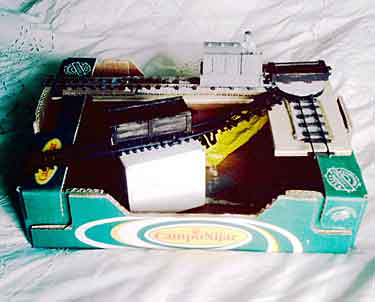
Take a closer look at the lefthand photo above. I’ve purposely left in some of the table and background so you can see it’s a color photograph! Bob has created a black-and-white look, through careful use of gray shades in his painting. It’s something I’ve always wanted to try, but never did. Bob has pulled it off!
About the layout Bob explains, “I have been working on a replacement for the Hayfinch Estate Light Railway [see Scrapbook #51]. The discovery of rich deposits of treacle ore have led to the opening of a new mining operation on the estate. The 15 inch gauge railway has been reopened to deal with the traffic. The loco is unpowered and operated, as was the original Hayfinch diorama, by fishing line. The turnplate can be rotated from beneath the baseboard and the wagon then propelled onto the side track using thin stiff wire.” For more information about the Hayfinch Treacle Mine, see Bob’s website.
THE COFFEE TABLE LAYOUT GETS A NEW TWIST
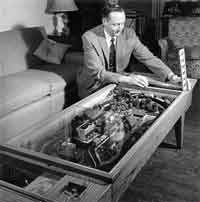
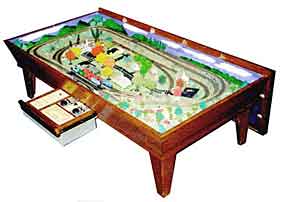
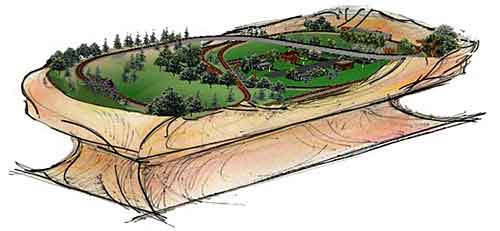
Chris Plumley has been building model railroads in coffee tables nearly all his life. He’s particularly interested in automatic control of the railroad. He started in 1958 with an HO circuit (upper left photo) controlled by a Stone Age computer. Then in 1963 he began building a second, more complex layout in the new N scale (upper right photo), but was thwarted and eventually sold the unfinished layout to another modeller. He is currently working on Coffee Table Layout No. 3 (lower photo), which was conceived in 1967 but is only now being constructed using 21st Century technology.
Chris describes CT-3 this way: “The latest layout will concentrate on everything — fine detail, multiple train operations, unusual operating scenery, automatic and manual train operation, remote train operations over the Internet, live video via a train-mounted camera, sound effects, and anything else I can think of as I go along. The whole thing will be mounted in a one-of-a-kind sculptured coffee table. You will be able to run the layout under glass, or if you prefer, remove the glass and let the layout rise to the surface of the coffee table. Each position – raised or lowered – will give the viewer an entirely different visual experience. It’s a huge project in a small package, and more fun than you can imagine.”
For lots more details and illustrations, see Chris’s website.
YOU’VE HEARD ABOUT THE ‘BLACK BOX’ — HAVE A PEEK INSIDE!
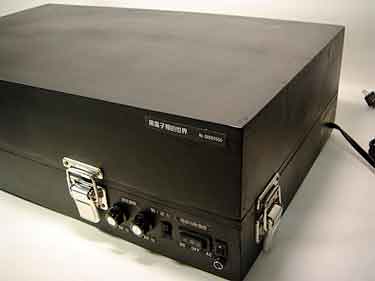
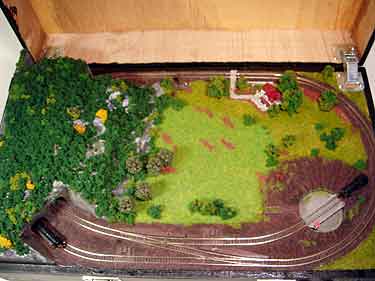
Jiun Wen Guo, our reporter in Taipei, Taiwan, forwarded this report about a very well-constructed “layout in a case” built by his friend, A-Bao.
“This Z scale layout named Black Box is made by Kuo Chang, Lu (nicknamed A-Bao) living in Tao-yuan city, Taiwan. The dimensions of the Black Box are about 55x33x15cm [21½x13x6in]. It is a double layer box where people can store books, trains, or tracks on the bottom layer, and the upper layer is the layout. A-Bao uses the Marklin Z scale Flex track for the main line. Also, his turntable is hand made.
“The most important thing for A-Bao’s style layout is that people can directly control the locomotive via the on-board control system using either a 9V battery or AC 110V power that the on-board DC transformer will change into DC 12V/1A.”
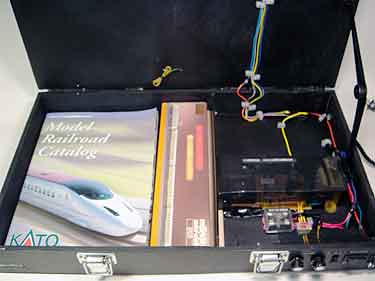
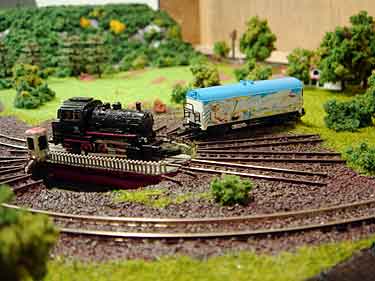
THE RETURN OF THE BOX FILES … IN A HERD
One of the favorite containers for model layouts in Britain – and to some degree on the continent – is the box file. For American readers: it’s a sturdy cardboard box with a snap catch that’s used on the other side of the Atlantic to store correspondence and other documents. The boxes measure roughly 38x26x8cm (15×10¼x3in), and they’re found in profusion around offices.
Examples abound of clever model railroads built in box files; for example, in Scrapbooks #18, #20, and #34. Now Matt Dawson, who lives Somewhere in Britain, has devised a cunning plan to take advantage of their herd instinct and line up numbers of box files to produce small layouts with some degree of variety.
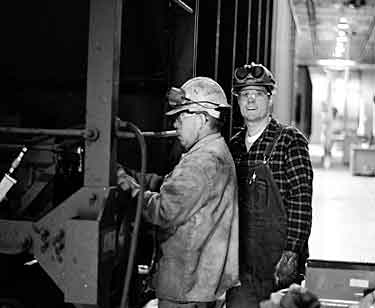
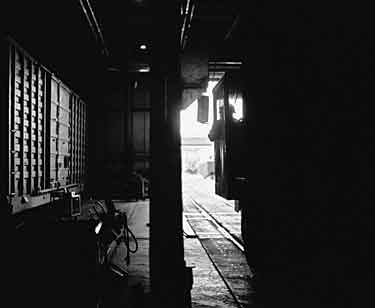
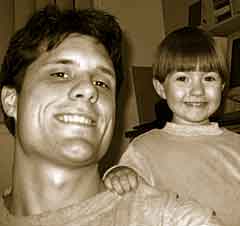
Matt’s first three designs are, from the left: country station, dock or canal shipment, and city outskirts station. They’re intended for Z, N, or Nn3 operation, but OO9 or HOn30 might be better suited, taking advantage of the smaller narrow-gauge rolling stock. These designs are all variations of the classic Inglenook design and the Two Turnout Theme; they can each be operated as an individual layout by adding an extension track to serve as a head shunt (drill track). Electric isolation sections are shown for use in this mode of individual operation.
But notice that Matt has placed the “main” track in each case at the back of the layout, equally distant from the edge. As a result the boxes can be lined up, connected with short lengths of track, and operated as individual stations in a larger railroad scheme. Like this:

Low-relief passenger platforms at the rear of each box provide destinations for passengers, and goods (freight) facilities are also available. The aggregation becomes a sort of “poor man’s modular layout system,” but on a deliberately small scale. There are more designs and info at Matt’s web page.
MORE THAN A ‘PIZZA LAYOUT’ CAN FIT A PIZZA BOX


Each year England’s Wealdon Railway Group holds a small-layout competition. In 2007 the object was to build an operating model railway in a 12x12in (30x30cm) pizza box. While the circular pizza layout is familiar to all (search “Pizza” in the Scrapbook Index), Andrew Knights decided to do something different. The result (above) is the Joshka Gemuse und Spargel (Köln) AG, an O9 (On18) 5-3-3 Inglenook in a pizza box!
Andrew built the locomotive on a Bachmann N-scale Plymouth chassis, and adapted six Colin Ashby OO9 cars. The extra narrow gauge format was perfect for being used as a feldbahn railway on a market garden. The layout’s operating pattern for exhibition purposes is slightly different from the standard Inglenook: “At the end of each session there should be three wagons in the back siding, one in the centre, and two wagons in the front siding. The special die is thrown to determine which two wagons should be exchanged. Simple…” Sounds like a splendid challenge in a severely limited space!
As a companion piece, Andrew also built a “Peter Pan” railway (below) – a model of the narrow gauge fairground railways found in England during the 1950s to 1970s. The originals were two-foot gauge, but Andrew built his model as a 15in gauge railway in O9 scale (7mm scale running on 9mm track). The serpentine track plan in the tiny 12in (30cm) square box gave rise to a contest during the exhibition: how long is the track in this layout?
(All four photos by David Thomas.)
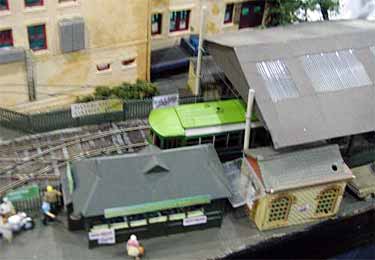
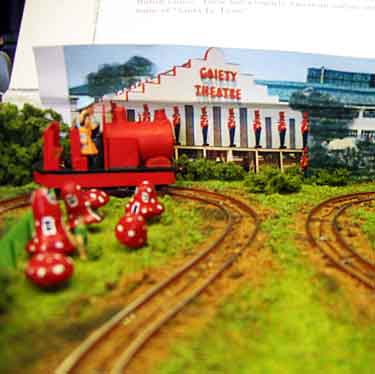
AND NOW … HERE ARE THE SHOEBOXES!
Layouts built in shoeboxes were an invention of this website sometime in 2002. During 2003 the efforts of a group of English and French modelers began to bring such layouts to the exhibition scene. By 2005 they were appearing regularly, and the French were describing them as “Arendtiennes.” By now, in 2007, these tiny gems have been developed into fine examples of model railway arts and ingenuity, as you’ll see in the recent work shown here.
DO WOODEN SHOES COME IN WOODEN BOXES?
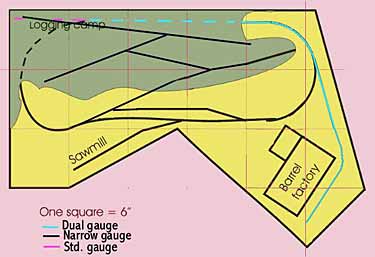
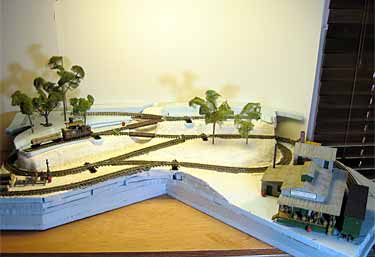
Actually, wooden shoes are threaded in pairs on a wire, rather than boxed. But John Hubbard, from Huntsville, Alabama, USA, couldn’t resist the pun – so he built Dijkman Klompen-Atelier (a Dutch wooden shoe maker located canalside in Amsterdam) in a wooden box with a 13x5in (33x13cm) footprint. A delightful little HOn30/HOe railroad serves the canalside factory, with the track plan forming a full-sized 5-3-3 Inglenook design.
John reports, “The rolling stock is Egger-Bahn and Roco. I’m using an Egger-Bahn ‘Fiery Elias’ steam dummy for two reasons: it seems appropriate for a street railway, and it is heavier than the other E-B locos and runs better. The cars are all Roco or E-B 4-wheel stock. The code 60 rail gave me some problems, so I had the engine’s driver flanges reduced to modern standards and replaced the wheelsets on the cars with those from MicroTrains N Gauge trucks. Pat Sanders at Trainworx out in Colorado turned the loco flanges to modern profile. No problems after that.
“The track and turnouts are from Shinohara (code 60) and the turnout radius is 150mm. The uncouplers were the most perplexing component. I wanted a completely hands-off operation because I was pretty sure that touching the layout would derail these little cars. I got lucky and found a great uncoupler from REPA/Uhlenbrock in Germany. It is a vertically mounted solenoid that directly lifts an uncoupling platform/ramp. The amount of lift is easily adjusted so it does not launch the cars into orbit.”
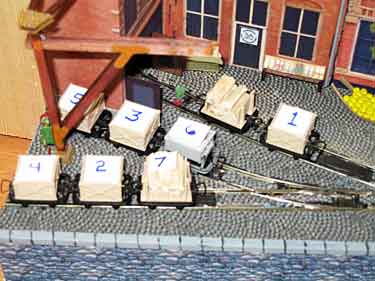
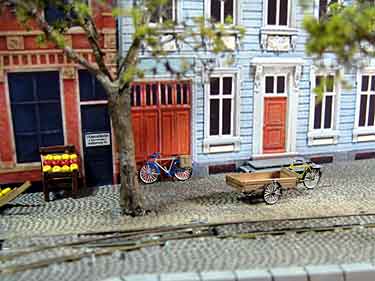
“The scenery,” John continued, “has been an interesting exercise. I found pictures of Dutch buildings on the internet and used Photoshop to scale them and correct perspectives, then printed them on matte photo paper. I mounted them on a cardboard backing and added a few details to give them some 3D aspects (steps, downspouts, lift beams). The Roman Cobblestone paving is a foam material from Faller that is about 1/16in thick and cuts very easily and cleanly. I made the Gouda and Edam cheese for the cheese shop from 8/0 beads from Hobby Lobby and printed some wooden shoes for the factory’s display because I could not figure any reasonable way to create such small shoes.”
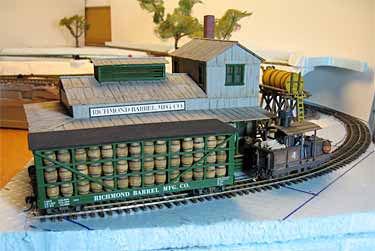
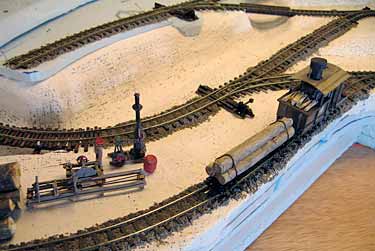
John loaded up on the controls and special effects systems. As the underfloor shot shows, there are two separate sound speaker systems – one for the steam locomotive sounds and the other for the ambient environment sounds that create the feeling of sitting canalside in Amsterdam (see sample below). Gathered together in front of the layout, the controls are almost larger than the train display! They include the turnout/uncoupler control panel, the throttle, the MP3 player for the ambient layout sound, and the MRC “Synchro Sound: Steam box” for the locomotive sound. The power supply and throttle board are in a another box!
John developed his own environmental sound system, and is preparing a magazine article on how to do it. He got some coaching and a bicycle-bell sound from Jim Wells at Fantasonics, who produce environmental sound systems. To give you a flavor of the effect, sit back and gaze at this panoramic view (below) of John’s imaginary Amsterdam canalside, and give a listen to a short excerpt from the longer tape he made using his computer. Just click on the little triangular “Play” control to begin the sound.
You can hear the full sound track and learn more about this fascinating little shoebox layout at John’s website.
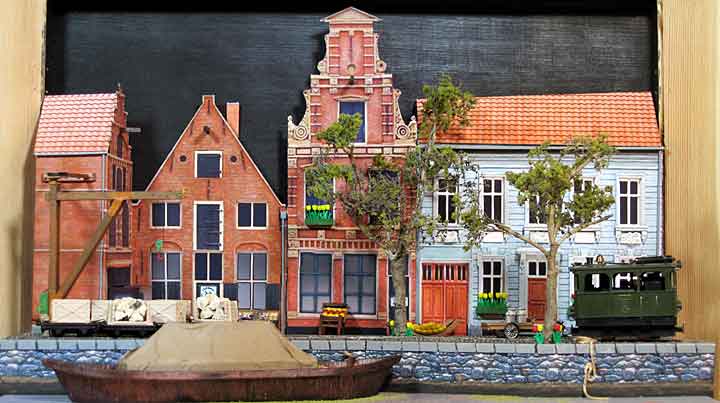
Click triangle to start sound; click parallel bars to stop.
SMALL O SCALE PLAN FITS A SHOEBOX WHEN TRANSLATED TO N
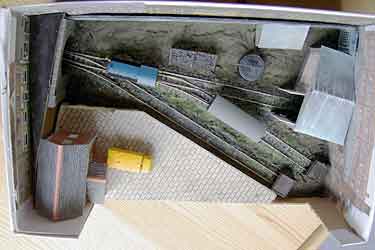
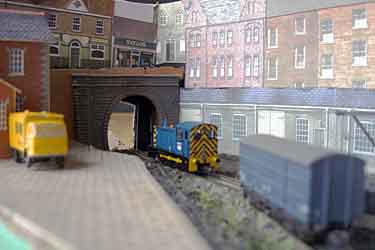
Alan Cox, from Swansea, Wales, has observed a number of O scale minimum-space railways that represent small 3-2-2 Inglenook yards. As an N scaler, he recognized that the same track pattern would fit nicely in a shoebox using N! And so Boot Lane Goods was born. It’s 28x18cm (11x7in), and the name suggests the origin of its container!
The overhead view shows the track pattern. Extension tracks with power connectors are used backstage under the bridge and behind the shed. Scenery is largely made of printed sheets from various suppliers artistically overlapped. Alan comments, “Trackwork is Peco Set-Track in order to fit the tiny space available. With 9ft or 10ft wagons and a straight track attached as the fiddle head it forms a classic 3-2-2 mini-Inglenook. With a straight track attached at the back of the shed as well, it allows the use of longer modern image wagons and also for open wagons to be shunted off-scene where cargo can be added or removed unobserved, supposedly in the shed.”
There are more photos and information at Alan’s website.
2MM ‘FINE SCALE’ WORKS FINE IN SHOEBOXES, TOO
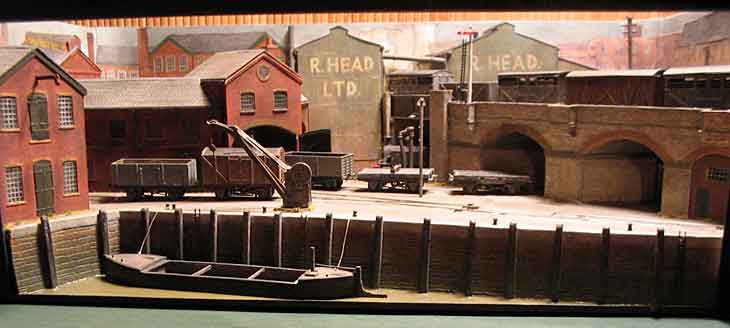
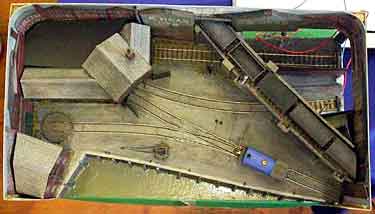 Paul Jones, who lives in North Wales, was inspired by this website a couple years ago to try his hand at a shoebox layout. He decided to build an industrial wharf in 2mm scale. In Britain, 2mm scale uses an exact scale gauge of 9.42mm and finer track and wheel standards than British N gauge.
Paul Jones, who lives in North Wales, was inspired by this website a couple years ago to try his hand at a shoebox layout. He decided to build an industrial wharf in 2mm scale. In Britain, 2mm scale uses an exact scale gauge of 9.42mm and finer track and wheel standards than British N gauge.
Paul’s track plan was based on Carl’s Imports with an extra siding and wagon turntable added. Paul was delighted to receive an award for the layout at the 2mm Scale Association’s annual meeting in 2005. Thanks to Mark Fielder for calling this nice layout to my attention.
Photo by Mark Fielder
‘FOLDAWAY’ SHOEBOX LAYOUT UNPACKS INTO AN INGLENOOK
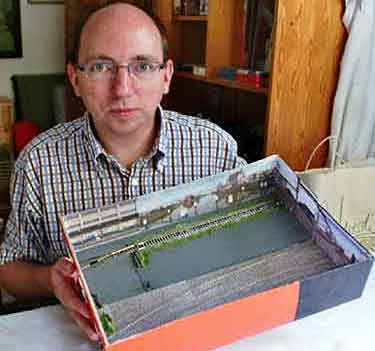

If you have a brother approaching his 40th birthday and procrastinating about building a model railway layout, what do you do? Alex Lehmann, (above left) from Mannheim, Germany, had such a brother (named Christian) … and he decided to build a “bare bones” layout as a birthday present. If you’re in a similar situation, and have a week of spare time available, you may want to follow along with what Alex did (shown in the photos above).
First, he started with a shoebox measuring 42x24cm (16½x9½in). Cutting it in half lengthwise, he then connected the two halves with three plastic hinges and added two 3mm plywood groundplates.
Next, Alex glued down two turnouts and a couple lengths of flextrack. He used TT gauge because his brother already had a collection of TT equipment (unused as yet).
Then Alex and his mother (a retired professional photographer) trekked into the Mannheim port and industrial area to make some suitable background pictures (those familiar with Mannheim may recognize the red building fronts on the left half — they’re from the well-known Mannheim store, “Röhrenlager”). Alex manipulated the photos in PhotoShop, printed them out on matte paper, and glued them to the background walls.
Ground cover came last, including cobble-stone cardboard from the local hobby shop (on the left half).
The results are shown below. The work required one week of time, with most of the construction effort being performed on a single weekend. Christian has now started work on detailing the layout and perhaps will be inspired to start his own railroad. As a bonus, his six-year-old daughter is fascinated with the layout and shunts the cars around even without an electrical supply or a loco!
Summing up, Alex commented that the whole project “was very much fun and had a kind of Christmas feeling.” And we wish the same to you!
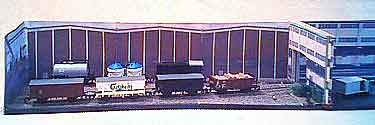
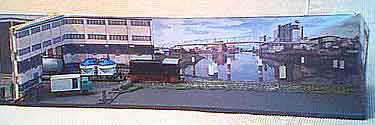
THIS INGLENOOK PACKS INTO A SHOEBOX!
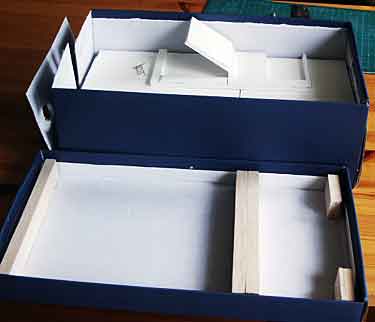
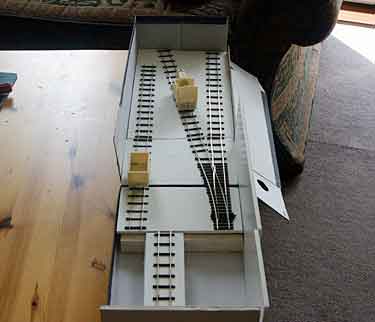
 Inglebox is a Gn15 layout under construction by Versif, a pseudonymous contributor from Kirkby in Ashfield, Nottinghamshire, U.K. The whole layout fits into a shoebox (above left) including the lid. It unpacks by removing the lid, unfolding the three flaps at one end, placing the lid next to them, and adding a filler piece to connect the shoebox proper with the traverser (transfer table) in the lid. The result is shown above right. The trials and tribulations of constructing the layout up to the point shown (below left) were chronicled by Versif in the Gn15 forum, The Gnatterbox.
Inglebox is a Gn15 layout under construction by Versif, a pseudonymous contributor from Kirkby in Ashfield, Nottinghamshire, U.K. The whole layout fits into a shoebox (above left) including the lid. It unpacks by removing the lid, unfolding the three flaps at one end, placing the lid next to them, and adding a filler piece to connect the shoebox proper with the traverser (transfer table) in the lid. The result is shown above right. The trials and tribulations of constructing the layout up to the point shown (below left) were chronicled by Versif in the Gn15 forum, The Gnatterbox.
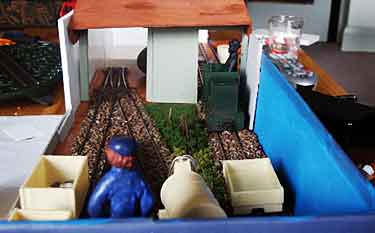 Now, of course, the layout will never be finished. Versif left a photographic record of its construction in a photo album, which will be available online for a limited time. The password, should PhotoBucket require it, is gnatterbox.
Now, of course, the layout will never be finished. Versif left a photographic record of its construction in a photo album, which will be available online for a limited time. The password, should PhotoBucket require it, is gnatterbox.
Versif built three other layouts, all reported in this Scrapbook. The first was the very complex Gnotter Yard (Gn15), now in the possession of his friend, Martin Hogg, and described in #35. The other two were scheduled for exhibition this Fall: Quad Y, later renamed ForeY (HO), in #56a; and his newest, Turner Point Yard (also HO) found in #57 and #63a.
by Jack Trollope, Ross-shire, Scotland
Petar and I had been “Internet mates” for several years. We had never met, but emailed frequently and spoke many times on the phone. His good humour and attitude to life and modelling will be greatly missed by all who knew him.
We had some surprising coincidences in our lives. He was a biker; I was (away back) a biker. He was a painter of fantasy figures and a war-gamer (that was where his soubriquet Versif Grotfang came from); I was a custom painter of fantasy figures for war-gamers. He modelled in HO and very recently N; I modelled in HOe, moved to N and then moved on to HO. He and I independently discovered and used XTrkCad. We both worked in Local Government (although many miles apart), and we both had a very similar, slightly off-beat sense of humour. I shall miss him greatly.
RIP, Petar. It was great to have known you – one of life’s truly Good Guys.
Leave a Reply